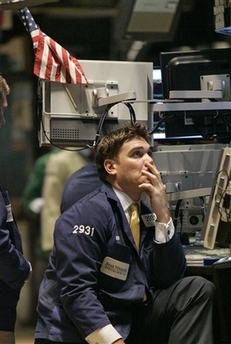Despite data, Fed leaves rates steady
(AP)Updated: 2007-08-08 09:48
Wall Street turbulence, Main Street credit problems and a nationwide housing slump pose increasing risks to the economy, the Federal Reserve said Tuesday, even as it left interest rates unchanged.
Although Federal Reserve Chairman Ben Bernanke and his central bank colleagues acknowledged challenges that have intensified since their last meeting in late June, they nonetheless expressed hope that the economy will safely make its way.
 Bear Wagner specialist Robert Tuccillo watches screens at his post on the floor of the New York Stock Exchange, Tuesday, Aug. 7, 2007. [AP] |
Against these economic crosscurrents, the Fed left an important interest rate at 5.25 percent on Tuesday. In turn, commercial banks' prime interest rate for certain credit cards, home equity lines of credit and other loans - would stay at 8.25 percent.
The central bank's key rate hasn't budged for more than a year. Before that, the Fed had raised rates for two years to fend off inflation.
On Wall Street, investors overcame their initial disappointment and bid stocks higher. The Dow Jones industrials gained 35.52 points to close at 13,504.30.
The Fed policymakers didn't signal that a rate cut - as an insurance policy against undue economic weakness - would be imminent. Analysts believe the Fed probably will leave rates alone at its next meeting on Sept. 18. But economists and investors think the odds are growing that the Fed might lower rates by the end of this year, if the economy shows signs of faltering and if inflation isn't worrisome.
"Financial markets have been volatile in recent weeks, credit conditions have become tighter for some households and businesses and the housing correction is ongoing," the Fed said. "Downside risks to growth have increased somewhat," it added.
Even so, policymakers stuck to a forecast that the economy is likely to expand at a moderate pace in coming quarters. They also said they expected "solid growth in employment and incomes" - vital ingredients to the country's economic health.
The Fed was faced with a delicate dance, analysts said. To maintain credibility, it needed to acknowledge recent market gyrations, fears about a worsening housing slump and worries about a spreading and painful credit crunch. At the same time, it needed to send a comforting message but not be viewed as overly optimistic or pessimistic.
"They acknowledged and rightly so, the elephant in the room - problems in the credit market. But they didn't feed it any peanuts by cutting rates," said Stuart Hoffman, chief economist at PNC Financial Services Group. "But the statement gives the Fed a little more flexibility - a crack in the door - for them to cut rates later on" if the economy loses traction, he said.
The meltdown in the housing and mortgage markets has caused home foreclosures to climb to record highs and has forced some lenders out of business. Fears that credit problems will infect the broader financial system and the economy have fed market turbulence over the past few weeks.
The free flow of credit is important to the smooth functioning of the national economy. Increasingly restrictive lending conditions can put a damper on peoples' ability to buy big-ticket items such as homes, cars and appliances. And it can crimp businesses' capital investment and hiring. That reduced appetite by businesses and consumers would slow overall economic activity.
"People on Wall Street have been undergoing tidal waves. The Fed could hardly ignore that ... but I don't think the Fed's view of the economy has changed materially," said Bill Cheney, chief economist at John Hancock Financial Services. "The Fed statement seemed designed to reassure and to calm," he added.
On inflation, the Fed policymakers again noted some improvements. But they indicated they would need to see a steady string of better readings before they would downgrade their inflation risk.
Gasoline prices receded in early August but remain past $3 a gallon in some cities.
Meanwhile, core inflation - excluding food and energy prices - closely watched by the Fed has moderated. These prices rose 1.9 percent over the 12 months ending in June, down from a 2 percent annual gain for May.
A government report Tuesday showed that productivity got a lot stronger in the second quarter, helping to restrain the growth of employers' labor costs. Analysts, however, believe the improvements on both fronts might be short lived.
After nearly stalling in the first quarter of this year, economic growth rebounded in the April-to-June period at a solid 3.4 percent pace. That bounceback came despite a drag on economic activity from the sour housing market and a much smaller appetite by consumers to spend. Growth through the rest of the year is expected to be slower.
Given that, the nation's unemployment rate - at 4.6 percent in July - is expected to climb close to 5 percent by year's end, analysts say.
|
||
|
||
|
|